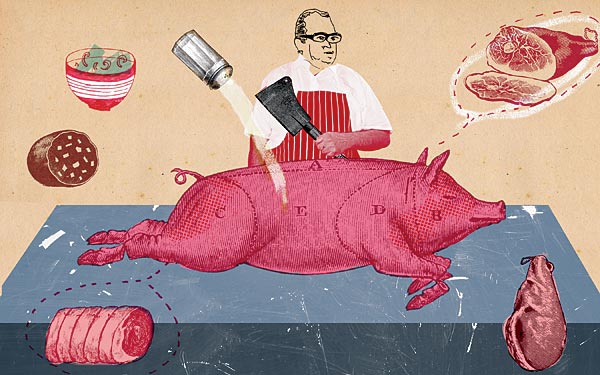
In his prime, my grandfather could cut a round steak so thin that the Italians in the neighborhood would come to him for beef to make braciola, the classic rolled meat dish. Towering slabs of beef would enter Jack O’Connor’s West Side butcher shop and leave as meticulously trimmed T-bones, briskets, and rib eyes. Two generations later, I’m five minutes into a beef-cutting demonstration at Kendall College, and I’m totally lost.
The recent foodie interest in butchering—a logical extension of the trend toward local and sustainable eating—is a painful reminder of everything I should know but don’t. When I read about classes taught by hipster meat cutters selling out instantaneously in Brooklyn or about the BBC airing a reality show looking for Britain’s top young butcher, all I can think is: Grandpa Jack is cooler than I am right now.
There are no rock-star butchers in Chicago yet, but the city’s trendiest restaurants—Publican, Nightwood, The Bristol—embrace the tail-to-snout movement. Rob Levitt, the chef/owner of Mado in Bucktown, receives a 180-pound hog from downstate every two weeks, which he breaks down and serves as everything from charcuterie to the romantic “pork shank for two.” Levitt loves to talk about the virtues of DIY butchering, and when I ask him to teach me my grandfather’s craft, he obliges.
A few days later, I’m standing at Mado’s prep table with Levitt and a headless beast. Levitt starts by gliding his utility knife along the seams in the muscle to free the prized tenderloin. Then, with a few swipes through the tendons between the hipbone and ball joint, the leg pops out, and—voilà!—a perfect Easter ham appears. Levitt hands me a hacksaw and puts me to work on the shoulder. I’m usually not good with tools, but I cut through the bone with the confidence of a logger; next I chop away the ribs with a machete. The loin (back) and belly sections are kept intact so they can be rolled and spit-roasted for the restaurant’s signature porchetta. But first they need to be skinned—by me.
“Angle the knife up,” Levitt instructs, “so if you slip, it cuts into the skin and not the meat.” Distracted by eight adorable pink pig nipples, I gash into the slick meat. After an hour, I give up. No amount of washing can get the blood off my hands, which makes for a fun little scene when I pick up my daughter from daycare.
Next up: Schmeisser’s in Niles, an old-school butcher shop that still cuts meat from hanging sides. Upon my arrival, Kurt Schmeisser, the third-generation owner, hands me an apron and a paper hat. “You can help us debone the geese,” he says, pointing to a workstation stacked with fowl, most of them destined to become spickgans, a pricey German specialty of smoked goose breast. Like my high-school prom date, Schmeisser doesn’t let me anywhere near the breasts—but he does let me cut off the legs and wings. “The knife has to be your eyes,” he says. “Use the tip of the blade to feel for the bone.” I follow his direction, and with a few fluid strokes, I sweep the legs cleaner than the blond dude from The Karate Kid.
After my goose duty is complete, I wander into the meat cooler and meet Salvador Cardenas, the shop’s 61-year-old meat cutter. Like my grandfather, he’s a union man, a holdover from the days when every neighborhood had a butcher shop. As I watch Cardenas effortlessly handle a hindquarter of beef and separate the sirloin from the round with a saw, I start to recognize the cuts. There’s the tri-tip roast and the eye round, where my grandfather used to slice those super-thin steaks for his customers. I ask Cardenas to do the same for me. On the drive home, my precious cargo in the passenger seat, I realize I’m still not as cool as Grandpa Jack. But I finally know where my dinner comes from.
GO: Mado offers monthly pig-butchering demos; call 773-342-2340 for details.
Illustration: Tonwen Jones/colagene.com


